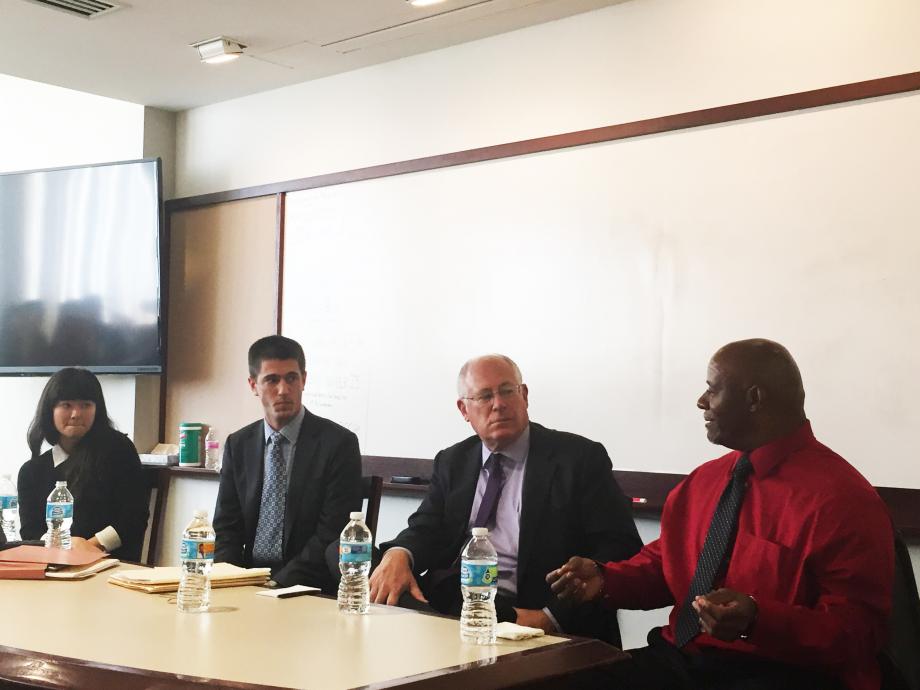Trying a Case Outside of the Courts

For Tyrone Hood, a man wrongly convicted of murder and sentenced to seventy-five years in prison, seeking clemency through former Illinois Governor Patrick Quinn was a novel approach. Hood’s release from prison and subsequent conviction dismissal—a victory for the Law School’s Exoneration Project—involved the exercise of executive power and a deliberate media strategy. These tactics were the subject of a panel discussion at the Law School that included Quinn; Hood; Karl Leonard, ‘09, who worked on the case as a student and continues to represent Hood; and Eva Nagao, the Managing Director of the Exoneration Project. The conversation was moderated by Lecturer Tara Thompson, ’03, an Exoneration Project staff attorney.
The Exoneration Project is a clinical project at the Law School that represents wrongly convicted individuals and gives students hands-on experience with representation and the criminal justice system. Hood’s long-anticipated exoneration was a win that required investigation from seven law students at the project over the last eight years.
“I really want to thank the Law School and everyone involved for making this day possible,” Quinn said during the panel.
After several attempts to prove Hood’s innocence through the court system, his lawyers at the Exoneration Project drafted a clemency petition for Quinn. “This case has been really special for us, because it was our biggest foray into finding more dynamic ways of trying a case outside of the courts,” Nagao said. Hood and his legal team were grateful that Quinn saw addressing clemency petitions as a crucial part of the governor’s role.
“The courts should’ve taken care of this problem, it should have never gone to Pat Quinn, but since it did, I’m glad,” Hood said. During his time in office, Quinn acted on more clemency petitions than any other Illinois governor, and on his last day he granted forty-three, including Hood’s.
Hood’s case first fell under scrutiny when evidence suggested that witness testimony connecting him to the murder was the product of police coercion. This evidence, along with proof that linked the victim’s father to the crime, garnered public support and led to extensive media coverage of his conviction.
Leonard, an associate at Winston & Strawn, stressed the value of using this media coverage advantageously. “The most important thing was that we had the contacts and that we used them at the right time,” he said. Their efforts brought the case to the Conviction Integrity Unit and ultimately the former governor. “Eva did a great job with the Twitter campaign and getting the stories out there to get the attention of people who could actually make a difference.”
The panelists also agreed that the criminal justice system needs improvement, and that Hood’s exoneration was delayed because of its flaws.
“It can’t be just the governor’s act of clemency or mercy that really gets this system fixed up—it’s got to be repaired much earlier,” Quinn said. The likely perpetrator committed two more murders while Hood was in prison, he added, “so these preventative measures are imperative for public safety.”
When asked about the Cook County State’s Attorney’s Office Conviction Integrity Unit that reviewed and upheld Hood’s conviction, Leonard said, “It has to be independent—it can’t be made up of the same people who were trying to prove that the conviction was right in the first place.”
Members of the Exoneration Project are currently filing for Hood’s certificate of innocence with the Court, giving the State’s Attorney’s Office the opportunity to weigh in. Having this certificate could expunge his record, seal the conviction, and provide him with compensation for the years he was prison.
“Would you say your case gives [those wrongly convicted] some hope?” Quinn asked Hood.
“They’ve just got to be persistent,” Hood answered. “And as far as seeing me get out, I know it brought them hope.”